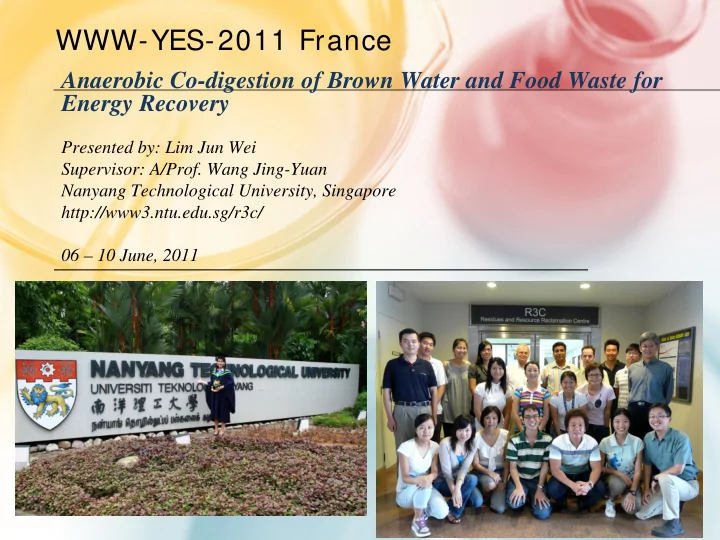

WWW-YES-2011 France Anaerobic Co-digestion of Brown Water and Food Waste for Energy Recovery Presented by: Lim Jun Wei Supervisor: A/Prof. Wang Jing-Yuan Nanyang Technological University, Singapore http://www3.ntu.edu.sg/r3c/ 06 – 10 June, 2011
Housing Development Board (HDB) Flats
Residues and Resource Reclamation Centre (R3C) Established in May 2009 to spearhead research efforts in developing sustainable waste management technologies Core Capabilities Plastic waste • Waste to Materials to PHA – Converting wastes into new and useful materials (e.g., plastic waste into Ashes to biodegradable PHA polymer, construction incineration bottom ash into stabilized material carbonated ash product for high value usage, etc.) • Waste to Energy – Harnessing energy from urban biomass, sewage sludge, agricultural residues, micro-algae, etc. • Contaminated Site Remediation – Develop solutions and technologies Food waste plant for biogas for remediating contaminated sites production Rooftop microalgae cultivation for biofuel production
Waste is not waste • Waste is a misplaced resource • Waste residues can be converted into reusable/new materials, energy, and other products with value • Natural resources are limited and depleted • Waste can be potential sources for resource recovery
Issues of Current Waste Management • We have not used resources efficiently • The centralized waste management approach is energy-consuming; it was ok but not for the future • Liquid waste: activated sludge process (water flushing + aeration + nitrification and de-nitrification + sludge dewatering + …) • Solid waste: collection and transportation (energy consuming) + emissions from incineration and landfilling (land contamination)
CRP Project : CRP Project Communities as Renewable Resource Recovery Centers
Separation of Brown Water, Yellow Water, and Kitchen Waste Kitchen basin Kitchen waste Separation toilet I + II Garbage grinder Sewer system Separation toilet Storage tank Storage tank Storage tank Wash basin + Storage tank Yellow water Brown water Kitchen waste + Garbage grinder
CRP Project : CRP Project Communities as Renewable Resource Recovery Centers • 300 residents / HDB block • 21 kg VS • 43 kg COD • 65% VS removal • 10 m 3 methane
Research Objectives and Scopes � To develop a three-phase AD system to optimize the production of methane from the co-digestion of Food Waste and Brown Water � Partial-aerobic hydrolysis reactor, an anaerobic acetogenic UASB reactor and a methanogenic UASB reactor Anaerobic co ‐ Anaerobic co ‐ digestion digestion Brown water Brown water • CH CH production potential production potential • 4 4 Biogas Biogas • Key variables/parameters Key variables/parameters • + • Lab Lab ‐ ‐ scale test scale test • Food waste Food waste • Process optimization • Process optimization Qualifying Further • 3 Modules WWW-YES 2011 France Exam studies • Literature Review • Preliminary Study Sept – Dec 2010 Jan – May 2011 Jun 2011 Jun’11 – May’12 2014 Sept – Dec 2010 Jan – May 2011 Jun 2011 Jun’11 – May’12 2014 • 3 Modules • Literature Review • Literature Review • Continuous, three-phase AD systems • Preliminary Study – Batch, • Enhance hydrolysis • Optimizing substrates of methanogens Methane Potential Tests
Four Steps in Anaerobic Digestion Particulate organic material Particulate organic material Proteins Carbohydrates Lipids Proteins Carbohydrates Lipids 1. Hydrolysis Amino Acids Amino Acids Fatty Acids Fatty Acids Sugars Sugars 2. Acidogenesis VFAs, alcohols, lactate, VFAs, alcohols, lactate, + , H 2 H 2 , CO 2 , NH 3 /NH 4 + , H 2 S H 2 , CO 2 , NH 3 /NH 4 S 3. Acetogenesis Acetate Hydrogen Acetate Hydrogen Hydrogenotrophic 4. Aceticlastic methanogenesis methanogenesis Methane Methane Adapted from Gujer and Zehnder (1983)
Batch Study on Anaerobic Co-digestion of Brown Water and Food Waste Experimental Design Substrate(s) Organic Loading (g VS/L) F/I ratio 1 Brown Water 0.3, 0.5, 1.0, 2.5 0.12, 0.20, 0.40, 1.0 2 Food Waste 0.3, 0.5, 1.0, 2.5 0.12, 0.20, 0.40, 1.0 3 Brown Water + Food Waste 1.0, 1.0, 1.0, 2.0 0.40, 0.40, 0.40, 0.80 Seed Sludge = 20% (v/v) Working Volume = 70mL BW:FW mixing ratio (in terms of VS added) = 1:1, 3:7, 7:3, 1:1
Materials and Methodologies 1. Collection and treatment of samples 2. Sample Preparation 3. Measuring gas production 4. Analytical Methods 1
Materials and Methodologies 1. Collection and treatment of samples 2. Sample Preparation 3. Measuring gas production 4. Analytical Methods Conditions: Tap 2 � Batch –30 days Water Substrate � Anaerobic Mix Well � 35 ° C Prepare 1 L X 10 sets mixture � Continuous mixing Inoculum Working Vol.= 70 mL • Analytical Tests (every 7 days/ at the end of study) 3 4 � pH � TS, VS � Biogas Composition – %CO 2 , %CH 4 � COD � Intermittent pressure VFA release method
Results (Biogas Yield) Brown Water Food Waste Brown Water Food Waste 1gVS/L 1gVS/L Co-Digestion Co-Digestion substrates substrates
Results (pH) Brown Water Food Waste Brown Water Food Waste Co-Digestion Co-Digestion
Results (Total VFA) Brown Water Food Waste Brown Water Food Waste Co ‐ Digestion Co ‐ Digestion
Results (Individual VFA)
Conclusions on Batch Study � Brown water / Food waste Tests • At least 90% of final biogas yield & VS reductions achieved in 21 days • Methane content: 55 – 78% • Biogas production potential of BW > FW • F/I of 0.4 – 1.0 � Co-Digestion Tests • Varying mixing ratio has little effect on biogas yields • Acetic acid accumulation towards the end of digestion period • Requires longer degradation time
Future Work � Synergistic relationship between BW & FW in co-digestion � Continuous system � Phase separation • Reduce HRT in each phase • Minimize VFA accumulation effects Single-phase Fed-batch Two-phase Continuous
Acknowledgements • Gujer, W., Zehnder, A.J.B. 1983. Conversion processes in anaerobic digestion. Wat Sci Tech 15(8-9), 127-167 • National Research Foundation of Singapore (NRF-CRP-2009-02) • National Environment Agency, Jurong Town Corporation, and Housing Development Board (Singapore) • Lionapex, SembCorp, and Keppel (Singapore) • Technical University of Hamburg and Harborg (Germany) • National Chung Kung University (Taiwan) • Nanyang Technological University (Singapore) • R3C-NEWRI
Recommend
More recommend